Oliver Jeffers is an artist and author from Northern Ireland best known for his successful career in children’s literature. Among his long list of award winning books are titles such as Lost and Found, The Great Paper Caper and Here We Are: Notes For Living On Planet Earth, which has been recently adapted to an animated short film. His illustration style, whilst approachable and child-like, is deceptively complex and combines hand drawn elements, mixed media and digital in beautifully crafted final pieces.
Ask Oliver Jeffers where he lives and he’ll tell you, “I'm living on Earth.” Having travelled the world promoting his many and various art projects and children’s books, he truly is a global citizen. Whether entertaining a fashionable New York gallery crowd, or a bunch of excited kinders, the universal appeal of Oliver’s work comes from his very on-point insights mixed with a wonderfully witty and understated humor.
His ability to turn everyday experiences, such as losing an expensive kite up a tree while on holiday in Rhode Island into his book — Stuck, is just one example of Oliver’s prowess as an observational storyteller. Even the unique non-ending of Stuck came from observing how easily kids get distracted as soon as you turn on a TV. Oliver transforms different encounters, observations, and experiences into stories and art, turning the seemingly mundane task of repainting an old house into a whimsical and playful concept about afterlife in his book — There’s a Ghost in this House. And then reinterpret the same experience into an immersive exhibition — A Fraid of Ghosts, highlighting a different take on life and death.
Oliver attributes his unique way of looking at the world to one very specific location. “I honestly think that comes from growing up in Belfast. There is a very unique sense of humor here. We have a very dark sense of humor, that is also generous. Everything is on the table to be picked apart, in terms of humor. Everybody would rather laugh than cry, so let's find humor in something, and just take the sharp edges off it.”

Oliver Jeffers and friend at his 'A Fraid of Ghosts' exhibition
“My sense of perspective comes from growing up and being able to translate between two different cultural identities in the pockets of a politically divided city: nationalism and loyalism. Being able to gently navigate my way through that, and hold two opposing ideas in my head at the same time. The only thing that really separates these people are the stories they tell and the flags that they fly. Fundamentally, they're the same people. By breaking something down simply enough, you can speak a universal language.”
This became even more apparent after his son was born, and he took on the task to explain the world in his award winning Here We Are: Notes For Living On Planet Earth, voted TIME Best Book of the Year. “I realized that I had a real ability to do that when my son was born. I needed to explain everything to him, and started writing him a letter about just the things that he was looking at. I was walking around and explaining, this is a tree, it gets dark at nighttime. I started writing just the simple facts of what being a human being on earth in 2015 was.”
“That was the build-up to Brexit, and Trump running for president. There just seemed to be a lot of anger around. And I started writing this book about, ‘We're just people.' I believed this could benefit other people… It was in making that book that I noticed that I have a knack for showing something complicated in a simple enough way that it cannot be... Not ignored, but... argued with. Because if you speak simply enough, and you just say what is absolutely fundamentally true, it just gives so many people an access point. And so many people can understand it.”
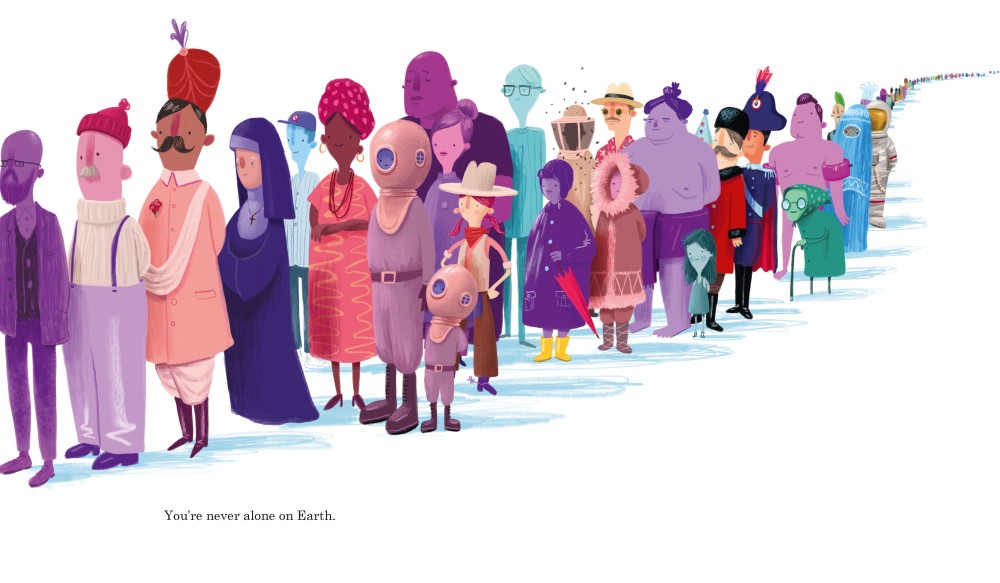
Uncovering fundamental truths are a large part of Oliver Jeffer's work and appeal.
Here We Are was recently adapted into an Emmy award winning short film for Apple TV+, narrated by Meryl Streep as Mother Earth. Adapting a 48-page book aimed at children into a 36-minute film for the whole family is a big challenge, but Oliver tapped into another fundamental human quality to help pull it off. “Working adaptations of books into film is a true collaboration. There's got to be a lot of trust in that. I was pretty involved in the process with Studio AKA, who I had worked with on Lost and Found.”
“I did end up doing a lot of the writing for both the structure and the conversation, the tone, and a lot of the still art that's in the film. It was an incredible but difficult process at the same time, because (the book) it's not a linear story. It's not even a story, really. It's a letter, it's an observation, it's a set of observations. To be able to turn that into the arc of the story was quite tricky. But really, it was Philip Hunt at Studio AKA, and Luke Matheny, the writer brought in by Apple, who came up with the final structure.”
If art is representative of the world at any given time with the artist as observer, Oliver’s unique perspectives help explain how he manages to maintain a successful full-time author and illustrator career while also pursuing his love of art. “I don't necessarily think of myself as an illustrator or as an artist. When I was at COP26 (The 2021 United Nations Climate Change Conference) they didn't have a box for ‘artist’, so on my Blue Zone pass they put me down as an observer and translator, and I thought that was surprisingly appropriate.”
“My friend, the French artist JR said, ‘Art is being willing to fail publicly.’ Another way of looking at it is — fine art, the industry, is akin to teenage dating. It's very, ‘I like you,’ but I'm not going to tell you. You like me, but you're not going to say anything. There's no contracts, everything's just reading the room. Whereas publishing is a business, there's a contract. You agree the fee before you start working. With fine art, you make it and then you try to figure out how to sell it.” With that being said, there is still plenty of creative cross over between the two worlds. “Often themes I'm covering in books I also tend to explore in the fine art world too. The things that are too deep or too strange for the books eventually find themselves in the fine art world.” Process wise, both practices involve lots of experimentation and trial, “Using Procreate is no different than using oil paints or watercolors. There’s no right way to do it. You’ve just got to experiment with it to see how it works for you.
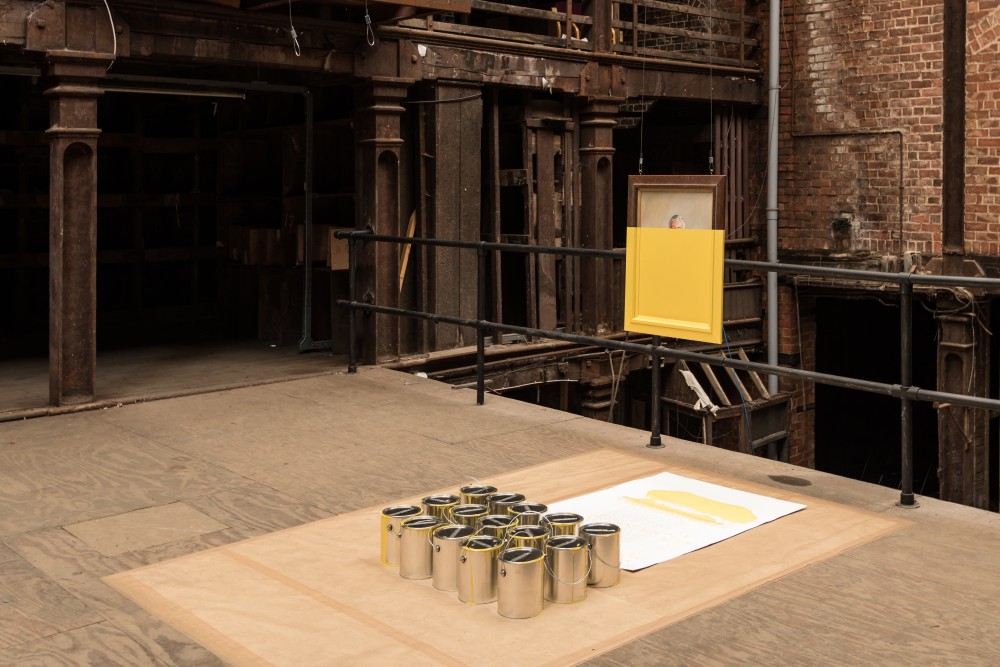
Oliver Jeffer's use of media is as diverse as his ideas.
A stand out of Oliver’s work is his incredibly diverse use of media — watercolor, acrylic, enamel, gouache and oil paint all feature, along with pencil, collage, and Procreate of course. The most important ingredient, however, is one that resonates heavily with us. “You have to leave time for play. A set time in the studio where there's no agenda, there's nothing that I'm specifically making for, I'm just making. That's where you take little risks and experiments, and things happen that you really like. Then you can take that and apply it to something where there's an actual timescale.”
“My creative process is mild panic. There's definitely a sense of urgency to everything I do. My creative process doesn’t involve drawing every day. I'm a very visual person, but I feel like I'm a visual translator. I do find it very handy to have a pencil and a notebook, but honestly, no two days are the same. It's like spinning plates constantly. I guess the daytime of my practice is organizational, and doing practical things. It's emailing, and scheduling, and doing interviews and things like that, and then most of the really good creative work that I do tends to be after the kids go to bed. That's the stereotypical life of the artist, where it's just me alone in my studio, no obstacles, nobody interrupting me. That's when the good stuff happens.”
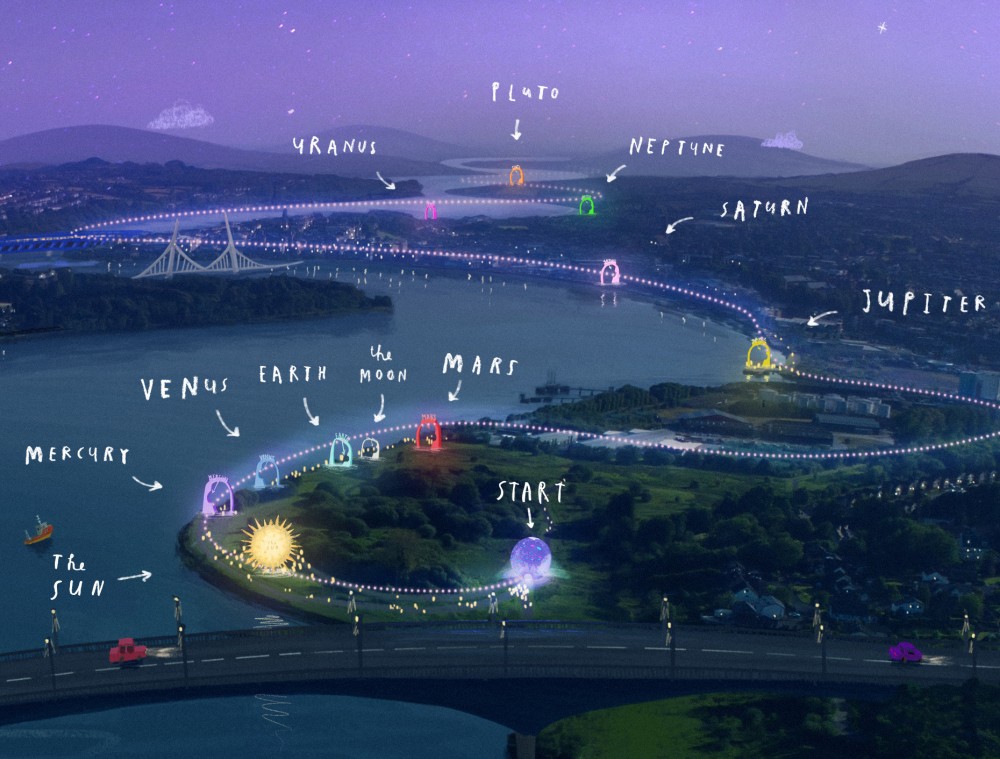
An early Procreate concept draw-over for 'Our Place in Space'.
The importance of 'play' shines through in Oliver’s most recent work, Our Place in Space. This time, it's the audience who is invited to let loose and play with our galaxy. “We opened a massive immersive sculpture project in Northern Ireland, which is a scale model of the solar system across a distance of nearly 10kms. The Sun is about 2.5m in diameter and 9.6km away is Pluto, which is the size of the head of a match. To scale any smaller, you wouldn't be able to physically see Pluto or the Moon. But it's a way of looking at humanity from a distance.”
“The whole point is that you can line your eyes up and see the next planet, so you don't need to know the (distance in) numbers, because you have spatial awareness. Like when you navigate a room, you have spatial awareness, so you don't need to know how many centimeters the door is. You can just see it. Once it clicks into place you feel the distance, that's all you need.”
“It's also about human conflict and what a waste of energy that it is. There's a book coming out, that I've just finished, which is attached to this. Using the speed of 37mph (the average speed humans drive at), if you were to leave this planet it would take you a year to drive to the Moon. And it would take you 78 years to drive to Venus, which is our closest planet, and 170 years to drive to Mars.”
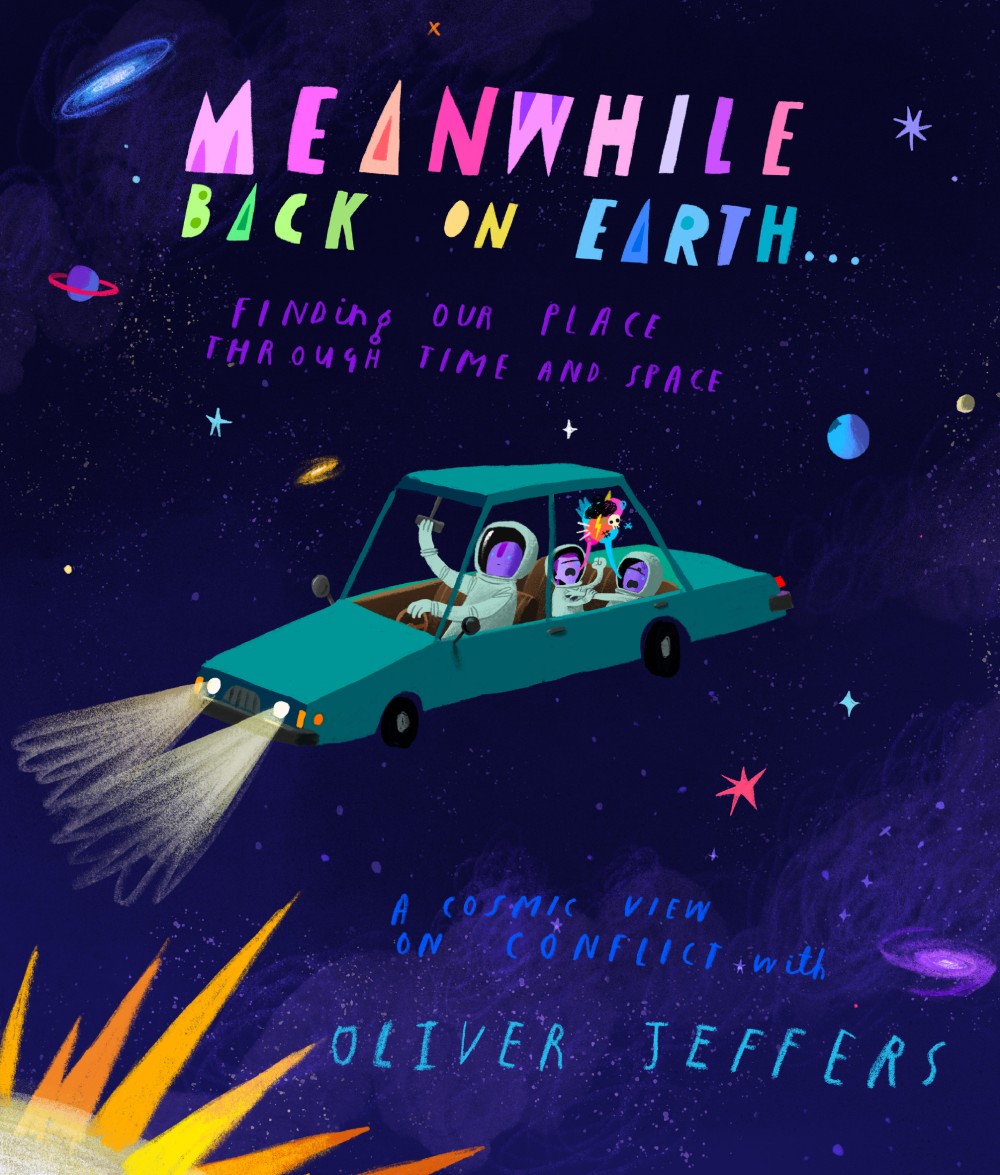
Oliver Jeffer's new book 'Meanwhile Back on Earth' is partially inspired by driving around with his kids in the back seat.
“Partly because it was inspired by my two kids squabbling in the back of a car, but also because I became aware of the way in which distance shifted perspective of the political problems of my home city (explaining from NYC for example). I use these time distances as a way to look back through human history, and shedding some perspective on how we treat each other. The only time in the book, and on the trail where humans weren't really at war with each other, was 11,000 years ago when you get to Pluto, where we were too busy trying to survive the raw elements. That's kind of where we are again now (today), except we haven't figured the ‘working together’ part out yet this time round.
It’s obvious Oliver’s mind is overflowing with ideas that won’t let him stand still, and that’s where Procreate’s portability comes in very handy. “What Procreate has become for me is a notebook that I can show people anywhere on the planet instantly. The last book that I just made, Meanwhile Back on Earth, was made 100% in Procreate.” And now Oliver’s kids get to play and enjoy all the fun Procreate provides as well by drawing over their Dad’s work, “I have the Here We Are cover that still has my son’s layer on it. That’s the actual, final piece of art. And then, that’s his version.”
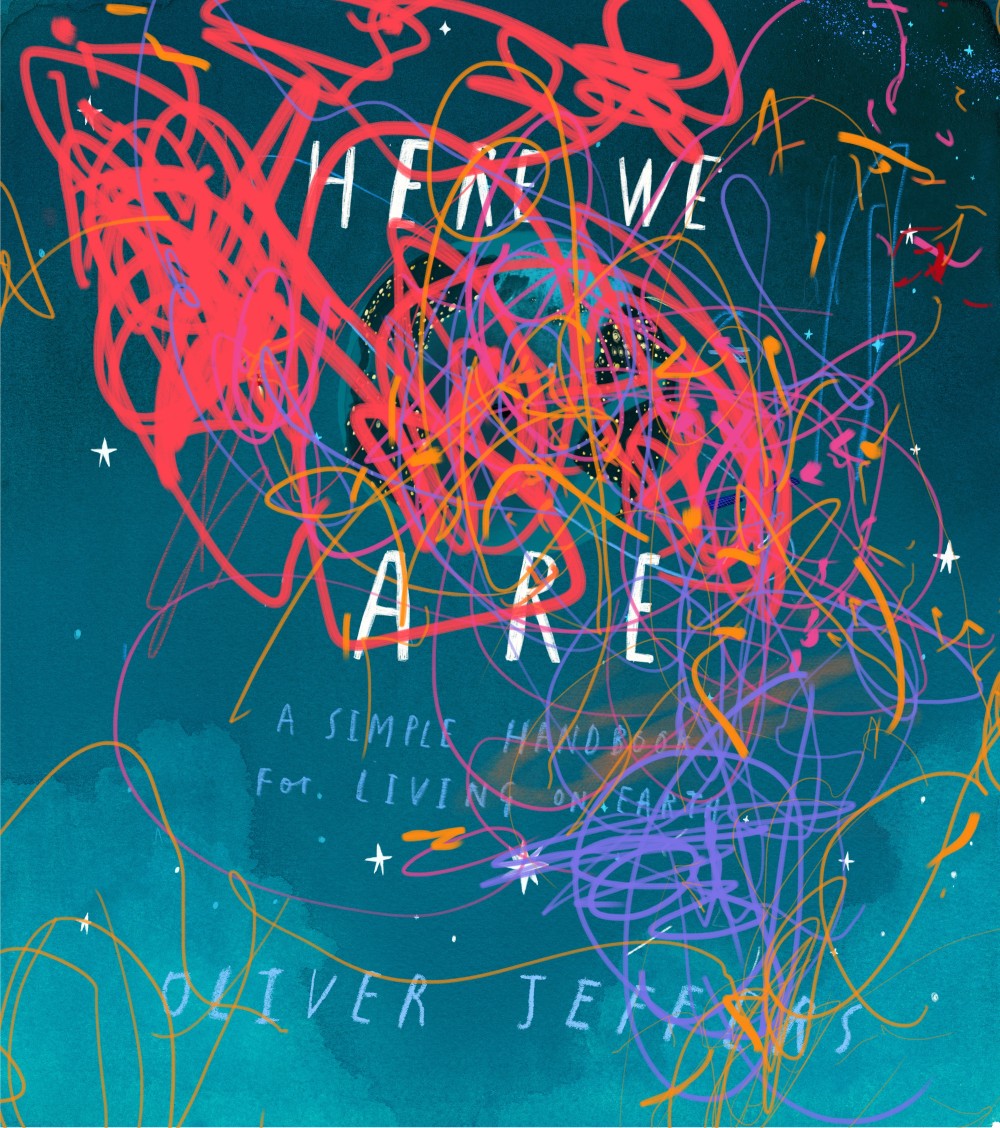
Talent runs in the family — Oliver's son's interpretation of his cover for 'Here We Are'.
Even when not working on 2D art, Oliver still finds Procreate useful. While working on Our Place in Space, “I was able to work in real time, traveling back and forth. The engineers would send photographs of the actual technical plans. He would send them as screenshots, I’d draw over them and send them back. That became an essential tool in the making of it.”
Always on the go, we’re excited to see where Oliver focusses his razor sharp observations and wit next. “I’ve been operating at about a hundred miles an hour for about six months. There’s a project coming up at the Isabella Stewart Gardner Museum in Boston, which I've got to finish the work for. That museum is the home of the largest-ever art heist in history, which there's a great Netflix documentary about called, This Is a Robbery. I get to stay in the apartment there. I think with a security guard, I can wander around at night with a flashlight. And then, the solar system project moves to Belfast. Then, I’ve one more book to finish and after that I'm taking the rest of the year off.” We wish Oliver all the best with his future creative endeavors, and even more so for his well deserved break.
Discover more of Oliver’s wonderful work at oliverjeffers.com and ojstuff.com, tune in for An ode to living on Earth on TED-Talks, or follow him on Instagram, Twitter and on his YouTube channel.